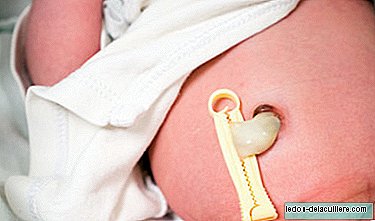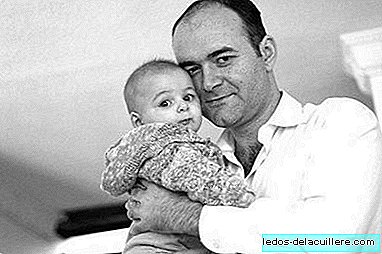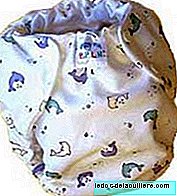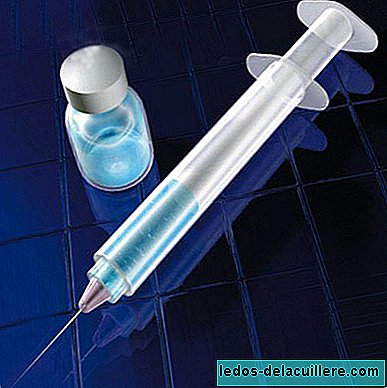
When the baby is born, the umbilical cord that attached to the placenta is cut and a clamp is placed to prevent blood. The umbilical cord stump detaches from the belly of the newborn between the second and third week of life and takes three to five more days to heal the wound. What are the warning signs that we must monitor during and after the process?
When caring for it, the most important thing is always keep it as clean and dry as possible, preventing it from getting dirty with feces or urine. After the cord falls, the risk of infection persists until the navel has not healed completely, so you should continue with the same care and vigilance until the gauze that covers it appears clean for a couple of days in a row.
 In Babies and more The umbilical cord in the newborn: everything you need to know
In Babies and more The umbilical cord in the newborn: everything you need to knowHow to clean the cord
To avoid infections, just clean it with soap and water and, above all, dry it very well.
There are parents who use 70º alcohol or other antiseptic solutions, but according to the AEPED "it has not been seen that these methods are better than simply cleaning the umbilical cord with soap and water and drying it well afterwards."
You can help keep it dry by wrapping it with a clean, dry gauze, replacing it every time we change the diaper and after bathing.
Alarm signs to watch
During the process of falling and healing some may appear umbilical cord abnormalities that is important for us to control, as they could result in major complications. For example:
Bleeding from the cord
Although it is normal that there is a slight bleeding of the umbilical cord of the newborn the first few days and then when it falls, we must watch it because there are certain signs that can indicate that something is not going well.
Small bleeding may be due to diaper rubbing, but it is not normal, for example, active bleeding that soaks the gauze. A hemorrhage, pus and swelling in the navel area are reason for consultation with the pediatrician.
Smelly yellow discharge
Similarly, if the cord is wet and has a yellowish (pus) and foul-smelling discharge, signs of an omphalitis or umbilical infection may occur.
Umbilical granuloma
Sometimes, after the fall of the cord, especially if it falls too soon or was very thick, a small lump of well-defined edges of pink or red color can be noticed, although it can also be whitish, yellowish or even grayish. It is an umbilical granuloma. This is not an infection, but it usually worries a lot since sometimes it suppurates a yellowish discharge.
It has no relationship with poor cord care, but it is important that if you observe a tissue that protrudes from the navel or suppuration, consult your pediatrician, who confirms that it is a granuloma will cauterize it with a topical application of silver nitrate .
Redness or inflammation of the navel area
Also, if you notice that the area around the obliteus is irritated (umbilical erythema) or inflamed, it could be a sign of possible infection. So, check with your doctor to assess it.
Fall Delay
The umbilical cord dries and usually falls between the fifth and fifteenth day after birth.
If after 15 days of life has not yet come off it is a reason for consultation. If a month passes and the cord has not fallen, in the absence of other pathologies, one could think of a deficit in the adhesion of neutrophils, a type of white blood cell. You have to go to the pediatrician to assess the situation and make the appropriate diagnosis.
 In Babies and more Abnormalities in the navel of the newborn
In Babies and more Abnormalities in the navel of the newbornUmbilical hernia
If the scar after the cut of the cord does not close properly, a small section of the intestine can exit through the umbilical ring producing an umbilical hernia, a soft bump that can be seen around the baby's navel.
It is caused by a failure or defect in the wall of the belly (like an eyelet) that allows the exit of that portion of the intestine. It can be minimal ("hernia tip") or giant (several centimeters in diameter and of prominence or bulge). There is talk of "omphalocele" if the hernia is large and is not covered with skin but a thin transparent layer.
Navel cutaneous and proboscis
Another one of the anomalies of the navel of which we have spoken to you have been the cutaneous and proboscis navels of the newborn. It occurs when a portion of cord skin sticks out. If its size is short, it usually disappears over time (cutaneous navel), but if it is long and with a tubal shape (proboscis navel) a surgical intervention may be necessary.
Fever and malaise
If the baby also has symptoms such as fever, malaise or decay It is also necessary to go to the pediatrician, since it could be a sign that the navel has been infected and the infection can spread to other parts of the body, which in a small child can be very serious.












